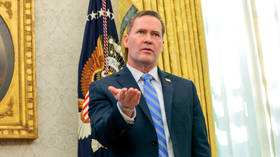Russia-US Document of Understanding on START follow-on

The text of the Memorandum of Understanding signed by Russian and US presidents in July 2009.
Fact sheet
The Joint Understanding for the START Follow-on Treaty
On April 1, Presidents Obama and Medvedev agreed in London that America and Russian negotiators would begin work on a new, comprehensive, legally binding agreement on reducing and limiting strategic offensive arms to replace the Strategic Arms Reduction Treaty (START), which expires on December 5, 2009.
On July 6, Presidents Medvedev and Obama signed a Joint Understanding to guide the remainder of the negotiations. The Joint Understanding commits the United States and Russia to reduce their strategic warheads to a range of 1500-1675, and their strategic delivery vehicles to a range of 500-1100. Under the expiring START and the Moscow treaties the maximum allowable levels of warheads is 2200 and the maximum allowable level of launch vehicles is 1600.
These numbers reflect a new level of reductions of strategic offensive arms and delivery vehicles that will be lower than those in any existing arms control agreements. The new treaty will include effective verification measures drawn from the experience of the Parties in implementing START. The new agreement will enhance the security of both the U.S. and Russia, as well as provide predictability and stability in strategic offensive forces. A follow-on agreement to START directly supports the goals outlined by the President during his speech in Prague and will demonstrate Russian and American leadership in strengthening the Non-Proliferation Treaty.
The U.S. and Russian negotiating teams met in April, May, June, and July, and will continue their work toward finalizing an agreement for signature and ratification at the earliest possible date.
THE WHITE HOUSE
Office of the Press Secretary
Joint understanding
The President of the United States of America and the President of the Russian Federation have decided on further reductions and limitations of their nations’ strategic offensive arms and on concluding at an early date a new legally binding agreement to replace the current START Treaty, and directed that the new treaty contain, inter alia, the following elements:
1. A provision to the effect that each Party will reduce and limit its strategic offensive arms so that seven years after entry into force of the treaty and thereafter, the limits will be in the range of 500-1100
for strategic delivery vehicles, and in the range of 1500-1675 for their associated warheads.
The specific numbers to be recorded in the treaty for these limits will be agreed through further negotiations.
2. Provisions for calculating these limits.
3. Provisions on definitions, data exchanges, notifications, eliminations, inspections and verification procedures, as well as confidence building and transparency measures, as adapted, simplified, and made
less costly, as appropriate, in comparison to the START Treaty.
4. A provision to the effect that each Party will determine for itself the composition and structure of its strategic offensive arms.
5. A provision on the interrelationship of strategic offensive and strategic defensive arms.
6. A provision on the impact of intercontinental ballistic missiles and submarine-launched ballistic missiles in a non-nuclear configuration on strategic stability.
7. A provision on basing strategic offensive arms exclusively on the national territory of each Party.
8. Establishment of an implementation body to resolve questions related to treaty implementation.
9. A provision to the effect that the treaty will not apply to existing patterns of cooperation in the area of strategic offensive arms between a Party and a third state.
10. A duration of the treaty of ten years, unless it is superseded before that time by a subsequent treaty on the reduction of strategic offensive arms.
The Presidents direct their negotiators to finish their work on the treaty at an early date so that they may sign and submit it for ratification in their respective countries.
Signed at Moscow, this sixth day of July, 2009, in duplicate, in the English and Russian languages.
FOR THE UNITED STATES OF AMERICA: Barack Obama
FOR THE RUSSIAN FEDERATION: Dmitry Medvedev













